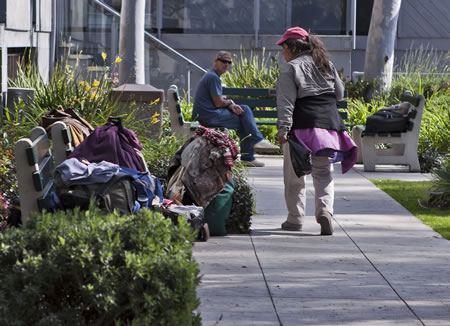
In evaluating whether a lawsuit over a homeless shelter in Laguna Beach meets certain legal tests, a federal judge raised the potential impact of such a ruling on the growing homeless crises in Orange County and elsewhere.
During oral arguments in Santa Ana, where a tent encampment of homeless people sprawls across a civic center plaza, Central District Court Judge Andrew J. Guilford quizzed a lawyer representing disabled homeless plaintiffs about the inhibiting effect of approving class action litigation.
“Should I be concerned,” Guilford asked. “The concern here is cities won’t open shelters,” he said, due in part to the threat of litigation or the cost of ensuring a building complies with accessibility rules. “Any roof may be better than none,” the judge pointed out.
In his tentative ruling, issued Monday, Oct. 3, Guildford supported class certification, which would allow the suit filed in August 2015 to proceed against Laguna Beach. The hearing allowed lawyers for both sides to reply to the tentative decision.
Peter J. Eliasberg, an attorney for the American Civil Liberties Union, who represents three homeless and disabled people in Laguna Beach, stood his ground.
“Are there programs that are invisible to ADA?” he asked, referring to the 1990 federal civil rights law, the American with Disabilities Act, that prohibits discrimination against individuals with disabilities in places open to the general public.
“We can’t treat people with disabilities as second class citizens,” Eliasberg said.
The judge pressed on. “A non-ADA compliant roof is worse than none at all?” he asked, and noted the “irony” of a similar 2003 lawsuit in his court that would have closed the Isaiah House shelter in Santa Ana because it failed to comply with some city regulations, including fire codes. It remains open, now equipped with fire sprinklers, Guilford said. “Is it better to have a roof without proper fire sprinkling than none at all?”
“Ask workers at the Triangle shirt waist factory,” replied Eliasberg, a reference to the infamous 1911 fire in New York City where 145 workers died, which resulted in worker safety regulations.
Coincidentally, the hearing came the same week an assessment was released of the county’s plan to end homelessness by 2020, saying it fails to follow the approved plan to shift the homeless into safe and affordable permanent housing. More than 4,400 people remain homeless in Orange County, a 5 percent increase since 2013, says the 41-page ACLU report.
In February, Guilford had denied a request for a court-ordered halt to enforcement of anti-camping laws in Laguna Beach and also cast doubt on the likelihood that the suit could succeed on its Eighth Amendment and ADA claims. Over the previous five years, police issued 540 citations for violation of the city’s anti-camping laws, the judge’s order and a court filing says.
While the judge’s comments broadened the discussion, the hearing actually concerned whether the lawsuit met legal standards that permit litigation by a class of plaintiffs rather than individuals.
The suit holds the city responsible for failing to provide chronically homeless disabled individuals a legal, safe place to sleep. The city’s practice of providing limited shelter to the local homeless population, while citing those forced to sleep outside because they can’t access the shelter “discriminates against, criminalizes, and endangers disabled, homeless persons and, in so doing, violates their civil rights,” the suit claims.
“Tell me how I got it wrong,” said Guilford, about his tentative ruling.
Michael Yoder, co-counsel for the City of Laguna Beach, described the tentative ruling as “misguided” because it fails to meet a common contention standard among the individual plaintiffs, David Sestini, Michael Newman and Richard Owens.
“To show ADA claims, they must show they’re excluded from the shelter because of their disability,” said Yoder, who described the varied circumstances of the three plaintiffs. Sestini was banned for bad behavior and was cited once for sleeping out of doors, Newman can stay at the shelter any time because of his local ties and Owens came from Idaho and has never been cited.
“You have to show exclusion from the benefit that is the ASL,” said Yoder, identifying the Laguna Canyon shelter by its formal name, the Alternative Sleeping Location. The 45-bed shelter opened in 2009 as a result of a settlement over an earlier lawsuit that challenged the city’s municipal code, which criminalized sleeping at night in public places. It is the only year-round municipal shelter in the county.
Shelter policies, such as allowing only locals to store their property, exclude people with physical disabilities, who can’t lug their belongings around, Eliasberg said. Many in the homeless population have mental disabilities, such as bipolar disorder, and cannot live in communal settings, he said.
“A disability class action requires certification despite varied disabilities,” said Eliasberg, who mentioned a possible remedy: an ADA study of the shelter and its users as well as an ADA coordinator.
Guilford made no mention of when he intended to issue a final ruling but urged both sides to negotiate a settlement.
Asked later whether the homeless crisis in Santa Ana injected a surprising tangent into the legal discussion, Yoder said he understood Guilford’s concern about a ruling’s potential consequence on a public issue. “I give him credit for thinking beyond the four corners,” he said.





[…] http://www.lagunabeachindy.com/court-tentatively-grants-class-status-homeless-suit/ https://www.aclusocal.org/issues/homelessness/nowhere-to-live/ […]
[…] a tentative ruling issued last October, Central District Court Judge Andrew J. Guilford supported class certification, […]